JKBOSE 10th Class Science Solutions Chapter 14 Heredity And Evolution
JKBOSE 10th Class Science Solutions Chapter 14 Heredity And Evolution
JKBOSE 10th Class Science Solutions Chapter 14 Heredity And Evolution
Jammu & Kashmir State Board JKBOSE 10th Class Science Solutions
J&K class 10th Science Heredity And Evolution Textbook Questions and Answers
BASIS AND BASICS
◆ Heredity. It is the transmission of genetic characters from parents to the offsprings i.e., from one generation to the next.
◆ Variation. The differences among the individuals of a species and also in the offsprings of the same parents are referred as variation.
◆ Every organism produced offsprings either through asexual or sexual reproduction. The individuals produced through these reproductive processes are similar but subtly different.
◆ In asexual reproduction, although all the offsprings resemble each other and also to their single parent, yet very minor differences (variations) arise in them. For example, if we observe a field of sugarcane we find very little variations among the individual plants.
◆ On the other hand in a number of animals including human beings, which reproduce sexually, quite distinct variations are visible among different individuals.
◆ Thus, the similarities between parents and their offsprings are due to “heredity” and the dissimilarities are due to “variation”.
◆ The origin of life on earth is an established fact. By the process of gradual and continuos change, living organisms have evolved to exhibit such a wide diversity.
◆ Continuity of life is maintained through heredity and evolution.
◆ Heredity explains that organisms resemble each other because they arise from common ancestor.
◆ Evolution is the orderly changes of various form through a slow but continuous process.
HEREDITY
◆ Concept of heredity is of ancient origin as shown by selective breeding of horses and cattle.
◆ Charaka knew that factors determine sex of a child.
◆ Heredity is the transmission of characters from one generation to the next.
◆ Heredity occurs within species.
◆ Genetics is the branch of biology which deals with the study of inheritance.
◆ Inheritance is transmission of characters from parents to offsprings.
◆ Variations are differences between young one of same parent. They differ from their parents.
◆ Variations arise due to inaccuracies in DNA replication in asexually reproducing organisms.
◆ In sexually reproducing organisms variations arise during sexual reproduction crossing over random fertilization and random segregation of genes.
◆ Lethal gene. The gene that kills the individuals.
◆ Mendel selected seven pairs of characters of garden pea (Pisum sativum)
◆ Mendel’s Laws of inheritance
1. Law of Unit Character
2. Law of Dominance
3. Law of Segregation
4. Law of Independent Assortment.
◆ The term gene was coined by Johansen.
◆ Morgan used Drosophila melanogaster, for experimental genetics to study inheritance of mutant traits.
◆ Males inherit X-chromosomes from the female parent and Y-chromosomes from the male parents.
◆ In diploid organisms with separate sexes a particular chromosome or a pair of chromosomes are associated with determination of sex. Such chromosomes are called sex chromosomes and others as autosomes.
◆ Human chromosomes at metaphase may be karyotyped.
◆ There are 22 pairs of autosomes and 1 pair of sex chromosomes in human beings.
◆ Sex lined genes are transmitted along a criss-cross pattern.
IMPORTANT TERMS AND FACTS TO MEMORISE
⇒ Genetics. The branch biology which deals with the study of heredity and variation is called genetics.
⇒ Heredity. The transmission of characters from generation to generation is called heredity.
⇒ Gene. The basic unit of heredity which transmits the traits into next generation.
⇒ Sex chromosome. The pair of chromosomes which decides the sex of male and female.
⇒ Homologous chromosome. The pair of chromosomes each from mother and father controlling a trait together is called homologous chromosome.
⇒ Autosomes. The chromosomes other than sex chromosomes are autosomes.
⇒ Evolution. The slow and continuous process of changing organisms from simple to complex is called evolution.
⇒ Homologous organs. The organs having same origin and basic structure but adapted to perform various functions.
⇒ Analogous organs. The organs having different origin and basic structure but perform same function.
⇒ Transgenic organism. The organism produced by the introduction of foreign DNA or gene.
⇒ Fossils. The remains of dead animals in earth strata are called fossils.
⇒ Haploid. The single set of chromosomes obtained from one parent.
⇒ Nucleotide. A molecule made up of nitrogen base, sugar and phosphate.
⇒ Chromatid. When the chromosomes divide into two each part is called chromatid.
⇒ Vestigial organs. Organs in our body having no functional importance are called vestigial organs.
⇒ Genetic drift. The effect on the genetic continuation in a population due to death of organisms or immigration is called genetic drift.
TEXT BOOK QUESTIONS (SOLVED)
Q. 1. If a trait A exists in 10% of population of an asexually reproducing species and trait B exists in 60% of the same population, which trait is likely to have arisen earlier ?
Ans. In asexually reproducing organism trait B originated earlier. The variations in a population are only due to inaccuracies of DNA copying.
Q. 2. How does the creation of variations in a species promote survival ?
Ans. The useful variation in individuals of a species will enable them to adapt according to the changes and new needs. Thus they will enable the survival of species.
Q. 3. How do Mendel’s experiments show that gene may be dominant or recessive ?
Ans. Mendel conducted experiments on garden pea plant selecting seven visible contrasting characters. He selected and crossed homozygous tall pea plant having the genotype TT with a homozygous dwarf pea plant having the genotype tt. F₁ generation consists only of tall plants, having genotype Tt. Since they have an allele for dwarfness also, they are all hybrids. The expressed allele T for tallness is dominant over the unexpressed allele t for dwarfness. The fact that the allele for dwarfness is present in the F₁ plants can be verified by inbreeding. them when F₂ progeny will consist of both tall and dwarf plants in the ratio of 3 : 1. On this basis he proposed “Law of Dominance.”
Q. 4. How do Mendel’s experiments proved that traits are inherited independently?
Ans. Mendel proposed Law of Independent Assortment on the basis of a dihybrid cross between two homozygous parents. He selected a dominant plant with round and yellow seeds and a recessive plant with wrinkled and green seeds, yields F₁ offspring showing the dominant form of both traits, viz. round and yellow. F₁ plants, on selfing, produce F₂ progeny with two parental and two new recombinant phenotypes, that is round yellow : round green : wrinkled yellow wrinkled green in the ratio of 9: 3:3 : 1. This ratio is called Mendel’s dihybrid phenotypic ratio. The factors (genes) of different traits are independent of each other in their distribution into the gametes and in the progeny. This is Mendel’s law of independent assortment.
Q. 5. A man with blood group A married a person with blood group O. Their daughter has blood group O. Is this information enough to tell you which of the blood group trait A or O is dominant. Why or why not?
Ans. As blood group is a hereditary character, the knowledge of blood groups of parents can give information about the possible blood groups of children and vice-versa.
In this case illustration is as follow:

In the above cross, 50 per cent of progeny will have A blood group and 50 per cent O blood group.
At the same time this data is insufficient. It is not mentioned father has homozygous or heterozygous A blood group. If it is homozygous A then 100 per cent of progeny will have A blood group as Gene IA is dominant over Gene IO.
Q. 6. How is the sex of child determined in human beings ?
Ans. Determination of the sex of child. Sex chromosomes determine sex in human beings. In males, there are 44+ XY chromosomes, whereas, in female there are 44 + XX chromosomes. Here, X and Y chromosomes determine sex in the human beings.
Two types of gametes are formed in male, one type is having 50%, X-chromosome, whereas the other type is having Y – chromosome. In female, gametes are of one type and contain X-chromosome.
The females are homogametic. If male gamete having Y-chromosome (androsperm) undergoes fusion with female gamete having X-chromosome the zygote will have XY chromosomes and this gives rise to male child.
If the male gamete having X-chromosome undergoes fusion with female gamete having X-chromosome, the zygote will be having XX-chromosome and this gives rise to female child.
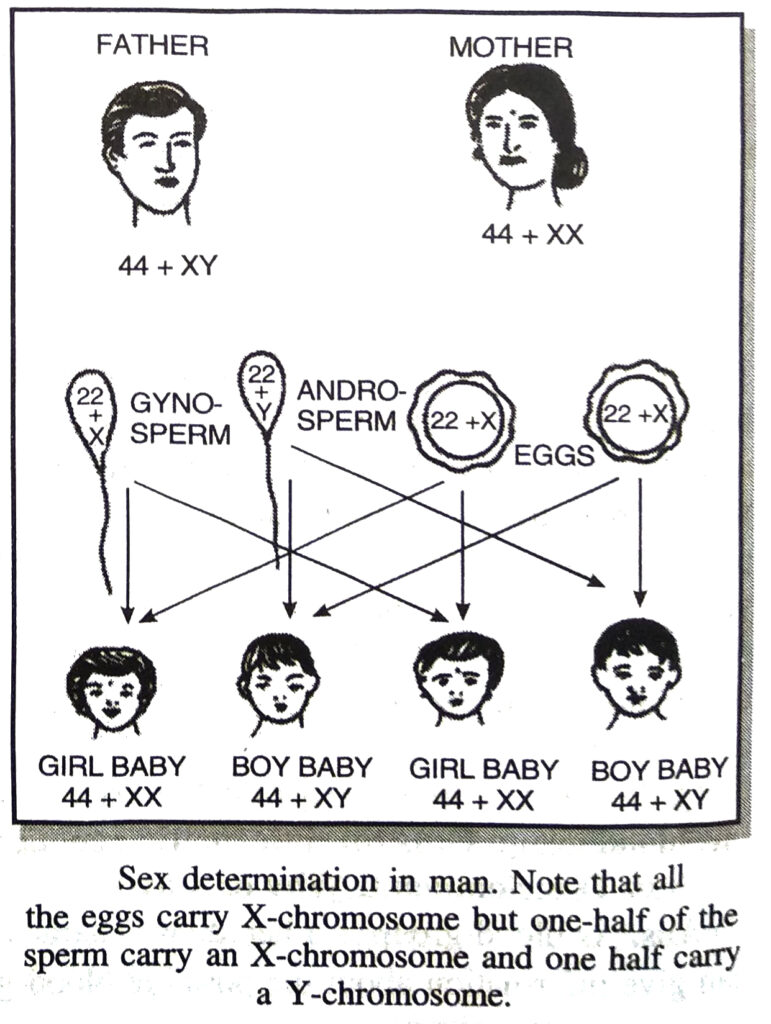
Q. 7. What are different ways in which individuals with a particular trait may increase in a population ?
Ans. A particular population with specific traits will increase due to following reasons:
1. Sexual reproduction which results into variations.
2. Natural Selection. The individuals with special traits survive the attack of their predators and multiply while the others will perish.
3. Genetic drift provides diversity without any adaptation.
Q. 8. Why are traits acquired during life-time of an individual not inherited ?
Ans. Change in non-reproductive tissue (somatic cells) cannot be passed on to the DNA of germ cells. Thus the acquired trait will die with the death of individual. It is non-heritable and cannot be passed on to its progeny.
Q. 9. Why are the small number of surviving tigers is a cause of worry from the point of view of genetics ?
Ans. As the population of tigers is decreasing, there is loss of genes from the gene pool. There cannot be recombinations and variations. Hence no evolution. If number falls suddenly they may become extinct.
Q. 10. What factors could lead to the rise of new species ?
Ans. Factors leading to rise of new species.
1. Genetic variations
2. Natural selection
3. Reproductive isolation
4. Origin of new species.
Q. 11. Will geographical isolation be a major factor in the speciation by a self- pollinating plant species? Why or why not?
Ans. No, in self-pollinating species, geographical isolation will not play any role for speciation because the self-pollination is occurring on the same plant.
Q. 12. Will geographical isolation be a major factor in the speciation of an organism that reproduces asexually ? Why or why not?
Ans. No, as there is neither genetic drift nor gene flow play any role during speciation. Moreover asexual reproduction involves single parent and natural geographical barrier can occur between different organisms.
Q. 13. Give an example of characteristic being used to determine how close two species are in evolutionary terms.
Ans. Homologous organs helps to identify the relationship between organisms. These characteristics in different organisms would be similar because they are inherited from a common ancestor. Example. Fore limbs of mammals having same basic structural plans in birds, reptiles and mammals. however the functions get modified in different species.
Q. 14. Can the wing of butterfly and wing of bat be considered homologous organs? Why or why not?
Ans. Wings of insects and wings of birds have different basic structural plan and origin. They perform the same function. Thus they are analogous organs and not homologous organs.
Q. 15. What are fossils ? What do they tell us about the process of evolution ?
Ans. Fossils are preserved remains, tracks or traces of organisms that lived in the past. Fossils have been found linking all major groups of vertebrates.
Significance of fossils
1. Fossils are direct evidences in support of evolution.
2. Living forms with simple organisation appeared earlier than the complex forms. We can conclude this because fossils of lower layers of the earth are simple as compared to fossils of the upper layers.
3. Several forms bearing intermediate characters indicate the transition from an earlier simple to a later complex form. Fossils of Archaeopteryx serves as a missing link between reptiles and birds. This bird has wings and unlike birds, it had teeth and a long tail.
4. On the basis of the fossil records, complete evolutionary history of present day horse has been studied.
Q. 16. Why are human beings which look so different from each other in terms of size, colour and looks said to belonging to same species ?
Ans. 1. The DNA studies have shown that the human beings belong to the same species.
2. Number of chromosome is the same.
3. All have originated from a common ancestor.
4. They interbreed among themselves to produce fertile young ones of their own kind.
Q. 17. In evolutionary terms can we say that which among bacteria, spider, fish and chimpanzee have a ‘better’ body design? Why or why not?
Ans. Chimpanzee have the better body design as compared to other three mentioned. They are better adapted for locomotion, communication and thinking.
TEXT BOOK EXERCISES (SOLVED)
Q. 1. A Mendelian experiment consisted of breeding tall pea plants bearing violet flowers with short pea plants bearing white flowers. The progeny all bore violet flowers, but almost half of them were short. This suggests that the genetic make-up of the tall parent can be depicted as:
(a) TTWW
(b) TTww
(c) TtWW
(d) TtWw.
Ans. (c) TtWW.
Q. 2. An example of homologous organs is :
(a) our arm and a dog’s fore-leg
(b) our teeth and an elephant’s tusks
(c) potato and runners of grass
(d) All of the above.
Ans. (d) All of the above.
Q. 3. In evolutionary terms, we have more in common with :
(a) a Chinese school-boy
(b) a chimpanzee
(c) a spider
(d) a bacterium.
Ans. (a) a Chinese school-boy.
Q. 4. A study found that children with light-coloured eyes are likely to have parents with light-coloured eyes. On this basis, can we say anything about whether the light eye colour trait is dominant or recessive? Why or why not?
Ans. On this basis we cannot say that light eye colour is dominant or recessive until a cross is made between parent having light eye colour and another with dark eye colour is made. Only then it will be possible to predict the dominant or recessive nature of the gene.
Q. 5. How are areas of study of evolution and classification interlinked ?
Ans. Evolution and classification are interlinked as evident from following points :
1. Characteristics are shared by most of the organisms. The characteristic in the next level of classification will be shared by most and not by all.
2. Cell designs also indicate this relationship.
3. Groups formed during classification are related to their similarities.
Q. 6. Explain the terms homologous and analogous organs with example.
Ans. Homologous organs. The organs of different classes have different forms because they have to perform different functions but their structures basically remain similar. Such organs are called homologous organs.
Example.
1. Fore limbs of amphibians, birds and mammals have same fundamental structural plans but perform different functions.
2. In plants, the homologous organs may be a thorn of Bougainvillea or a tendril of cucurbita both arising in axillary position.
Analogous organs. The organs are quite different in their structure and origin but similar in function. Such organs are known as analogous organs. The presence of analogous organs proves that different structures can be modified to perform a similar function. Analogy indicates convergent evolution.
Examples. The wings of insects and vertebrates perform the same function.
Q. 7. Outline a project which aims to find a dominant coat colour in dogs.
Ans. Make a chart or thermocol sheet showing the following monohybrid cross.
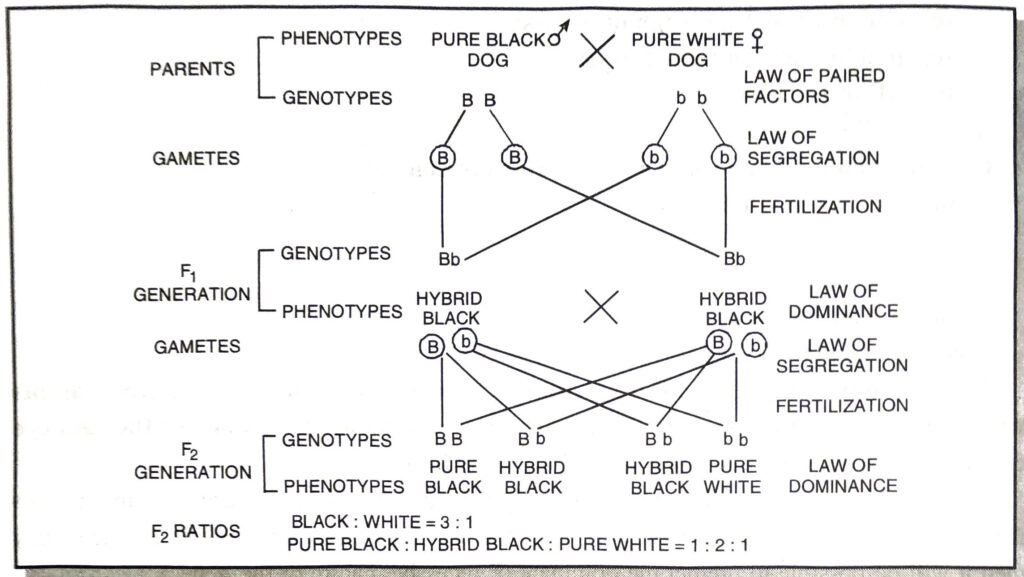
Q. 8. What evidence do we have for origin of life from inanimate matter?
Ans. Urey and Miller provided experimental evidence regarding origin of life from inanimate matter. They assembled an atmosphere similar to that, thought to exist on early earth.
In a spark flask they collected ammonia, methane and hydrogen sulphide, but no free oxygen over water at a temperature just below 100°C and sparks were passed through the mixture of gases to stimulate lightning. At the end they obtained organic molecules such as amino acid, urea, sugars. Amino acids which make up protein molecules. Thus they showed life originated from inanimate matter.
Q. 9. Explain how sexual reproduction gives rise to more viable variation than asexual reproduction. How does this affect the evolution of those organisms that reproduce sexually ?
Ans. Genetic variations arise in nature as a result of following mechanism during sexual reproduction are more viable and raw materials of evolution.
(i) Crossing over during gamete formation.
(ii) Random segregation of chromosome during meiosis at the time of gamete formation.
(iii) Random rejoining of gametes having different genetic set up in the chromosomes during fertilisation.
Q. 10. How is equal genetic contribution of male and female parents ensured in the progeny ?
Ans. During sexual reproduction fusion of gametes having haploid set of chromosomes belonging to male and female parents ensure equal contribution.
Q. 11. Only variations that confer an advantage to an individual organism will survive in a population. Do you agree with this statement? Why or why not?
Ans. Yes. The organism with useful variations will adapt and survive. Moreover they leave behind more offsprings and populations with such genetic variations will survive.
ADDITIONAL IMPORTANT QUESTIONS
LONG ANSWER TYPE QUESTIONS
Q. 1. Describe briefly Mendel’s experiment.
Ans. Mendel’s Experiment. Gregor Mendel (1822-1884) was an Austrian monk. He conducted experiments with garden pea (Pisum sativum). The results thus formulated the laws of inheritance. He studied inheritance of each character separately.
1. He selected two pure varieties of pea (Pisum sativum) which differed in size. One of them was tall and the other dwarf.
2. He cross-pollinated them. He placed the pollen of tall one of the stigmas of dwarf and vice versa.
3. The hybrid seeds obtained in both the cases were sown. Whichever way the cross was made, on germination the seeds grew into plants which were all tall. This first hybrid generation, is called the first filial generation and is usually written as F₁.
4. The hybrids of F₁ generation were all similar to the tall parent. The result of this generation surprised Mendel. He expected the hybrids to be intermediate in size.
5. Accordingly the character which appeared in the F₁ generation (tallness in this case) he called dominant and the other which did not appear he called recessive.
6. Mendel’s next step was to allow the F₁ hybrids to self-pollinate and produce seeds. He collected the seeds, planted them and observed the results. He found that three-fourths of the plant of F₂ generation were tall like the original tall parent and one-fourth dwarf like the original dwarf parent. The result of F₂ generation was all the more surprising to Mendel.
Q. 2. Explain Monohybrid cross.
Or
Explain Mendel’s Law of segregation with an example of monohybrid cross.
Ans. Monohybrid cross. It is a cross in which only one character is considered at a time. In a cross between tall and dwarf plant, the size of stem is considered. Mendel made a cross between pure tall (TT) and a pure dwarf (tt) pea plant as follows:
1. Mendel selected a tall pea plant represented by the genes (TT) and a dwarf pea plant represented by the genes (tt). Pea plant is self pollinating.
2. He removed the anthers of a tall plant and stigma of a dwarf plant, deposited pollen grains of dwarf plant on the stigma of tall plant and obtained seeds.
3. When the seeds were placed in the soil and allowed to grow he obtained only tall plant (Tt), although he was expecting the plants of an intermediate size. These plants were labelled as plants of First filial generation (F₁ generation).
4. In F₁ generation all plants were tall because the character tall is dominant over the dwarf.
5. He allowed the plants of F₁ generation to self-pollinate. Gametes formed by meiosis contained only one gene of a character because genes separate at the time of gamete formation.
6. The seeds thus obtained were placed in the soil and allowed to grow.
7. The plants formed were tall and dwarf in the ratio of (3 : 1).
8. Genotypically pure tall, hybrid tall and dwarf were in the ratio of 1: 2: 1. These were labelled as plants of F₂ generation.
Diagrammatically monohybrid cross can be represented as shown below :
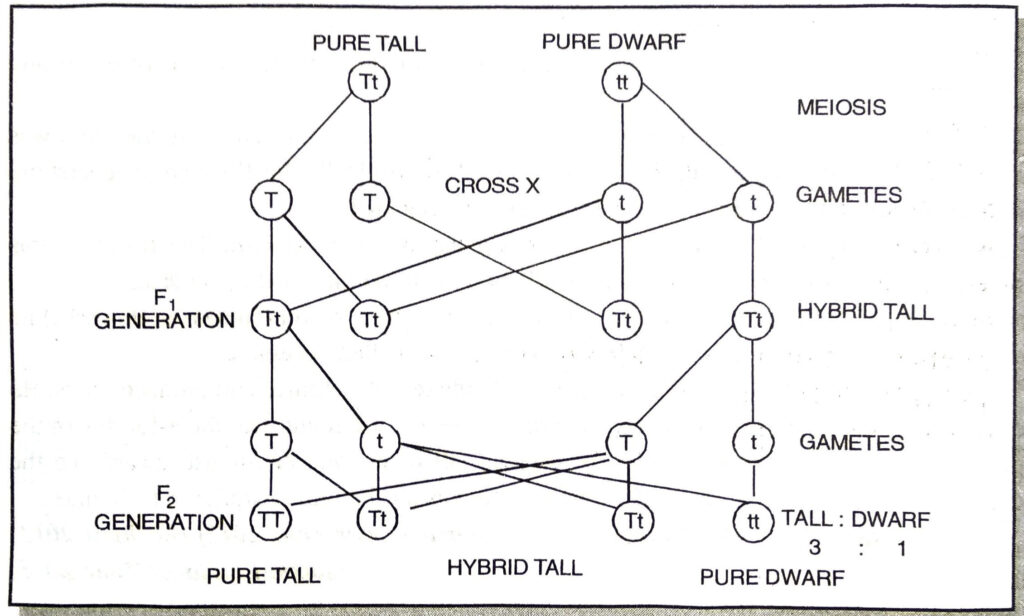
Q. 3. Explain the law of independent assortment with a dihybrid cross.
Ans. Law of independent assortment. According to this law, the factors of different pairs of contrasting characters, do not influence each other. They are independent of one another in their assortment to form new combination during gamete formation.
Dihybrid cross. A cross in which two characters are taken into consideration during experimentation, such a cross is called dihybrid cross. A cross between a pea plant with yellow smooth and a pea plant with green, wrinkled seeds are considered.
Explanation. When a cross is made between pea plant having yellow smooth seeds (YYSS) and a pea plant with green wrinkled seeds (yyss). At the time of cross pollination, yellow smooth (YYSS) produce gametes with genes (YS) and green wrinkled will produce gametes with gene (ys). Gametes unite at random. The seeds obtained when placed in soil will grow to form plants and produce seeds which are yellow smooth (YySs) because yellow and smooth characters are dominant over green and wrinkled. These are called as plants of F₁ generation.
When plants of F₁ generation are allowed to self pollinate, gametes formed YS, Ys, yS and ys by meiosis, they unite at random forming seeds. The plants thus obtained were called as F₂ generation. They are Yellow smooth (YYSS, YySS, YSSS, YYSS); yellow wrinkled (YYss, Yyss), green smooth (yySS, yySs) and green wrinkled (yyss) in the ratio of 9:3:3:1. The result of dihybrid cross can be shown below in the chequer board.
From the above dihybrid cross, it can be derived that each gene is assorted independently of the other during its passage from one generation to the other or Law of independent assortment is justified.
Q. 4. Read the following chart and answer the questions given below :
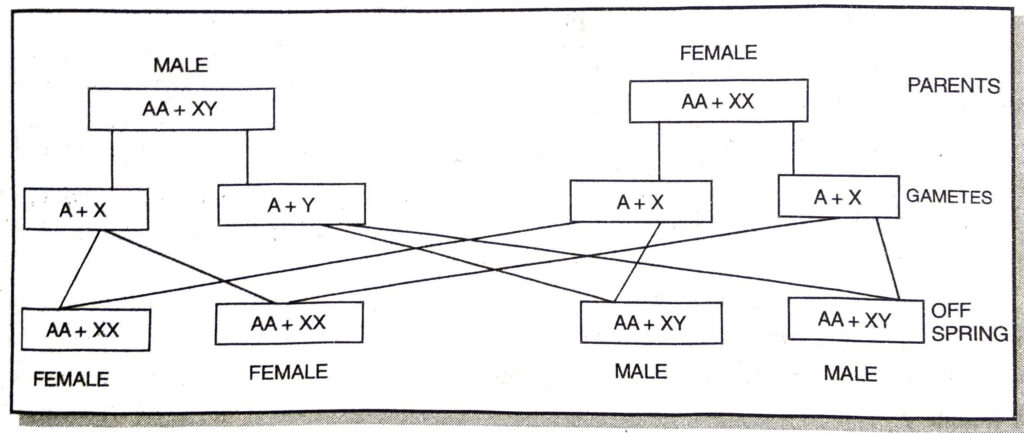
(i) What does the above chart show?
Ans. The chart shows the process of determination of sex with the help of sex chromosomes.
(ii) How are human males different from human females on the basis of gamete formation ?
Ans. Males are heterozygous and females are homozygous.
(iii) Which chromosome is responsible to produce a male child?
Ans. Y-chromosome.
(iv) What ratio of male children of female children is shown ?
Ans. 1 : 1 or 50% male and 50% female children. :
Q. 5. Give a graphic representation of mechanism of gene expression.
Ans. Mechanism of gene expression.
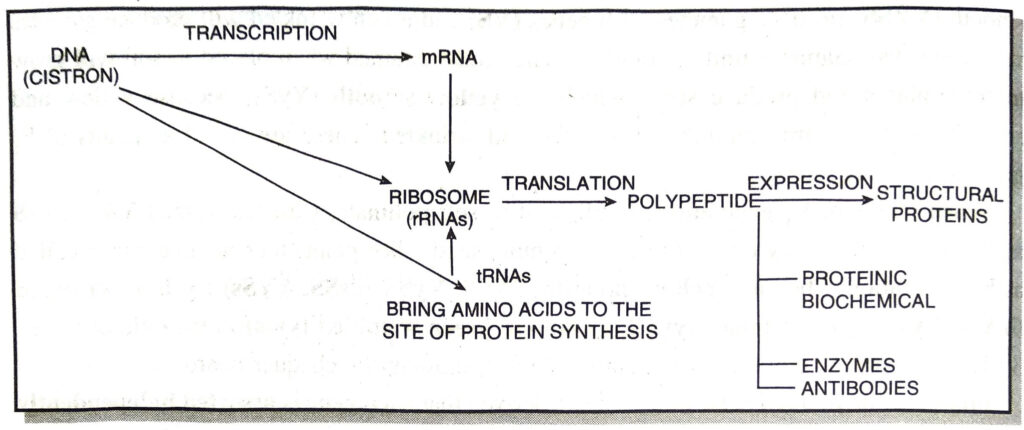
Q. 6. What will be the blood groups of the children of following matings?
(a) IA IB × IB IB
(b) IA IO × IA IB
(c) IA IB × IA IB
(d) IO IO × IA IB
Ans. (a) When a cross is made between IA IB × IB IB, then the two individuals will belong to blood group AB and two to blood group B.
(b) Similarly when a cross is made between IA IO × IA IB, then the two individuals will belong to blood group A, one to AB and one to blood group B.
(c) When a cross is made between IA IB × IA IB, then the two individuals will belong to blood group AB, one to A and one to blood group B.
(d) When a cross is made between IO IO × IA IB, then the two individuals will belong to blood group A and two to blood group B.
Q. 7. How will you determine the blood groups of a cross between AB and heterozygous A female ?
Ans.
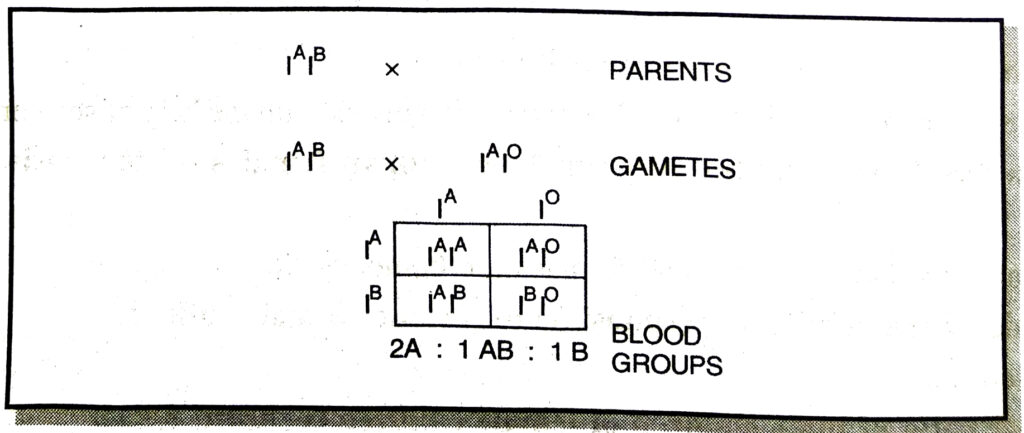
Q. 8. (i) Which of these represent male or female :

(ii) How many pairs of chromosomes are present in humans?
Ans. (i) A represents male and B represent female.
(ii) 23 pairs.
SHORT ANSWER TYPE QUESTIONS
Q. 1. What is meant by heredity ?
Ans. Heredity. It is defined as the transmission of characters from parents to offspring or from one generation to the successive generations of living beings.
We observe in our daily life that similarities tend to be greatest between members of a family-between the offspring of parents. Children tend to resemble parents, even grandparents and persons of earlier generations. The similarities are not due to coincidence but rather due to inheritance or heredity.
Q. 2. What is genetics ?
Ans. Genetics. It is that branch of science which deals with study of heredity (inheritance of characters) and variations. It deals with inborn characteristics of the organisms. Genetics also deals with inborn differences between offsprings of family and related organisms.
Genes are carriers of characters and present on chromosomes. Mendel is considered as “Father of genetics.”
Q. 3. Differentiate clone and offspring.
Ans. Differences between Clone and Offspring
| Clone | Offspring |
| 1. Clone is derived from a single parent as a product of asexual reproduction. | 1. An offspring is formed from two parents as product of sexual reproduction. |
| 2. Clone is a product of mitosis and meiosis does not occur. | 2. Meiosis occurs prior to formation of gametes. |
| 3. There is no recombination of genes. | 3. Recombination of genes occurs. Thus offspring differ in genetic constitution from either of its parents. |
Q. 4. What are the causes of variations in clones ?
Ans. Causes of variations in clones
Clones have the same genetic make up but variations appear in clones due to following reasons:
(i) Inaccuracies during DNA copying.
(ii) Effect of environment termed acquired variations.
(iii) Mutations. These are sudden stable abrupt changes and they are discontinuous inheritable as produced due to changes in genetic make up.
Q. 5. Explain the term variation.
Ans. Variation. No living organisms are alike and they vary appreciably in many structural and functional aspects. These differences between individual organisms are called variations.
Q. 6. Write one difference between continuous and discontinuous variations.
Or
What do you mean by discontinuous variation ?
Ans. Differences between continuous and discontinuous variations
| Continuous variations | Discontinuous variations |
| 1. They are small indistinct differences from the normal conditions and called fluctuations. | 1. They are large distinct differences from the parents and termed as mutations or sport. |
Q. 7. What is the importance of variations ?
Or
How does the creator of variation in species promote survival ?
Ans. Importance of variations :
1. They enable the organism to adapt themselves to changing environment.
2. They form raw material for evolution and development of new species.
Q. 8. Write three basic features of inheritance.
Ans. According to Kolreuter, basic features of inheritance are:
1. The traits could be hidden or masked for one or more generation but ultimately reappear unchanged.
2. Traits may remain together in one generation and separate in subsequent generations.
3. One alternate of a particular trait may be exhibited more frequently, than the other alternate form.
Q. 9. Differentiate acquired traits and inherited traits.
Ans.
| Acquired traits | Inherited traits |
| 1. These traits are not passed to next generation. | 1. These traits are passed on to the next generation. |
| 2. Change in somatic cell (non- reproductive) cells/tissue cannot be passed on to DNA of germ cells. | 2. Change in germ cells (reproductive cells) are passed on to next generation. |
| 3. No role in evolution. | 3. Play vital role in evolution. |
| 4. Example: Low weight of beetle. | 4. Example: Red colour of beetle. |
Q. 10. Mention the information source of making protein in the cell. What is the basic event in reproduction ?
Ans. (i) DNA (Deoxyribose Nucleic Acid) directs the synthesis of proteins through mRNA (messenger RNA).
(ii) DNA copying is essential part of the process of reproduction.
1. DNA copying provides cellular apparatus in the daughter cells.
2. DNA in daughter cells will be able to control the functioning of daughter cells.
3. DNA copies will retain the traits.
Q. 11. Why did Mendel choose garden pea for his experiments ?
Ans. Mendel selected pea plant (Pisum sativum) because :
1. Many varieties were available with observable alternative forms for a trait or characteristic.
2. Peas are normally self pollinated; as their corolla completely enclose the reproductive organs until pollination is completed.
3. It was easily available.
4. It has pure lines for experimental purpose, i.e., they always breed true.
5. It has contrasting characters. The traits were seed colour, pod colour, pod shape, flower shape, position of flower, seed shape and plant height.
6. Its life cycle was short and produced large number of offsprings.
7. The plant is grown easily and does not require care except at the time of pollination.
Q. 12. Make a table showing characters of pea selected by Mendel.
Ans. Characters of garden (Pisum sativum) selected by Mendel
| Heritable variations | Dominant | Recessive |
| 1. Plant height | Tall (T) | Dwarf (t) |
| 2. Flower and pod position | Axial (A) | Terminal (a) |
| 3. Pod colour | Green (G) | Yellow (g) |
| 4. Pod shape | Inflated (I) | Constricted (i) |
| 5. Seed coat | Coloured (C) | White (c) |
| 6. Seed shape | Round (R) | Wrinkled (r) |
| 7. Seed (cotyledon) colour | Yellow (Y) | Green (y) |
Q. 13. How can the pea plant be prevented from self-pollination? How is cross pollination carried out ?
Ans. Self pollination in pea is prevented by Emasculation (removal of anthers before the pollen matures). Cross pollination in pea is carried out by removing the anthers before pollen matures and then dusting stigma of these pollen flowers of desired plant.
Q. 14. What is monohybrid cross ?
Ans. Monohybrid cross. It is a cross in which only one character is considered at a time, e.g., in a cross between tall and dwarf plant, the size of stem is considered. Mendel made a cross between pure tall (TT) and a pure dwarf (tt) pea plant.
He obtained all tall (hybrid) plants in F, generation. On selfing these plants produced tall and dwarf in the ratio of 3:1 The genotypic ratio of 1: 2: 1 and phenotypic ratio of 3 : 1 is termed monohybrid ratio.
Q. 15. State and explain principle of dominance.
Ans. Law of Dominance. According to this law, when two factors of a character are unlike, one of them will manifest in the body and is called dominant while the other remains hidden and is termed recessive factor.
The law can be well explained by the monohybrid cross by studying the following crosses :
(i) Pure tall = TT, Hybrid tall = Tt
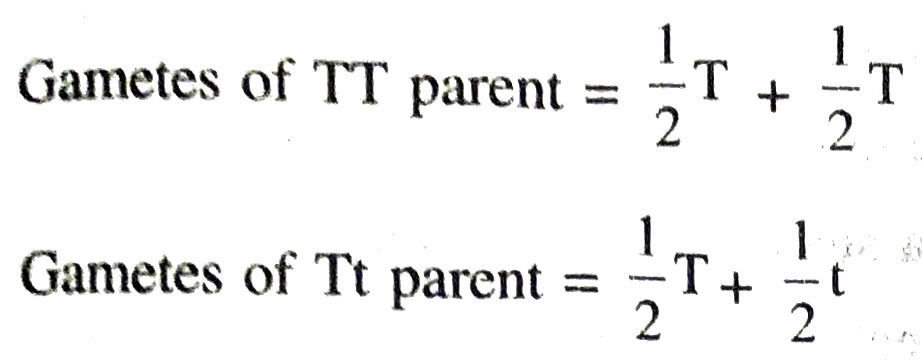
The 50% are pure tall and and 50% hybrid tall. Then pure tall plants will produce 100% tall in F2 generation and hybrid plants will produce in the ratio of 1: 2: 1 in the F₂ generation.
(ii) When the cross is made between pure tall and pure dwarf, we get results as follows (Fig. )
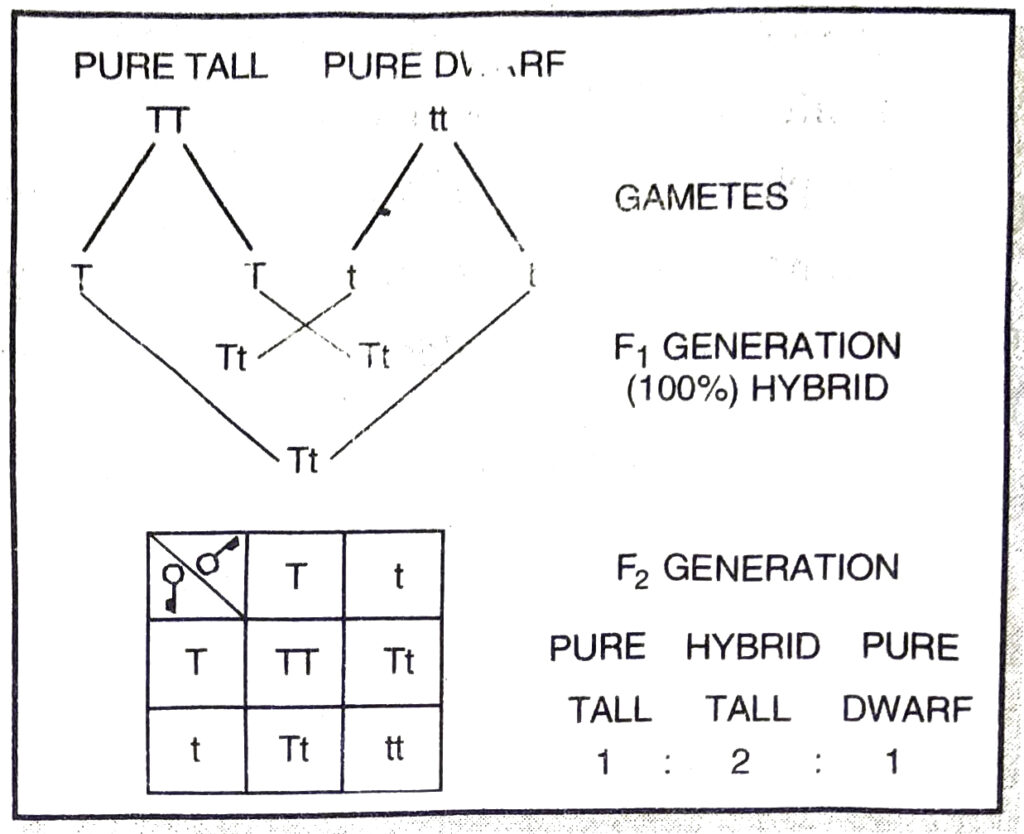
Q. 16. Write the various conclusions and hereditary principles drawn by Mendel from a monohybrid cross.
Ans. Conclusions and hereditary principles derived from monohybrid cross.
1. Principles of paired factors. Each character is represented in an individual by two determinants / factors / genes. They are same in homozygous which breed true. In hybrid or heterozygous individuals two factors represent alternative forms.
2. Principle of dominance. In a heterozygous individual only one allele is able to express its effect called dominant while the other remains hidden termed recessive.
3. Principle of purity of gametes. A gamete receives only one of the two genes or factors, thus gametes are always pure for a character.
4. The two genes or determinants do not mix up.
5. Homozygous individuals breed true whereas heterozygous give a phenotypic ratio of 3:1.
6. Principle of segregation. The two factors of a character keep their identity in an individual. They segregate (separate) during gamete formation and are passed on to the offspring randomly after fertilization.
Q. 17. What is a dihybrid cross ?
Ans. Dihybrid cross. A cross in which two characters are taken into consideration during experimentation, such a cross is called dihybrid cross. A cross between a pea plant with yellow smooth seeds and a pea plant with green, wrinkled seeds are considered.
From the dihybrid cross, it can be derived that each gene is assorted independently of the other during its passage from one generation to the other or Law of independent assortment.
Q. 18. What is dihybrid ratio ?
Ans. Dihybrid ratio. The ratio obtained in a dihybrid cross is called dihybrid ratio. It is 9:3:3:1.
Q. 19. State Mendel’s Laws of segregation and independent Assortment.
Ans. 1. Law of Segregation. According to this law, in a hybrid, the two unlike factors of a character do not affect each other but keep their identity. During gamete, formation, they are free to segregate or separate from one another and to be redistributed in the next generation. This law is also called the purity of gametes.
2. Law of Independent Assortment. When two pairs of independent alleles are brought together, they show independent dominant effects. During the formation of gametes, the genes of different characters are independent of one another.
Q. 20. Write short note on biological significance of Mendel’s laws.
Ans. Mendel’s work remained unnoticed for about three decades. But after its rediscovery, the laws are being used for the various branches of breeding. These are used for improving the varieties of fowls and their eggs, in obtaining rust resistant and disease resistant varieties of grains. Various new breeds of horses and dogs are obtained by cross breeding experiments. The science of eugenics is the result of Mendelism.
Q. 21. Why is Mendel known as father of genetics ?
Or
Write contribution of Mendel.
Ans. Gregor Johann Mendel in 1866 demonstrated the way in which characters are transmitted from one generation to another and suggested that each cell of an organism contains two factors for each character, both of which separate and are passed on to different progeny through different gametes.
Mendel (1822-1884) showed that the units of heredity, the factors or genes are stable and particulate. Mendel performed his experiments on Pisum sativum (Garden pea).
Thus Mendel laid the foundation of genetics, the science of heredity and variation, hence it is proper to call him father of Genetics.
Q. 22. In human beings blue eye colour is recessive to brown eye colour. A brown eyed man has a blue eyed mother.
(a) What is the genotype of man and his mother?
(b) What are possible genotypes of his father?
(c) If man marries a blue eyed woman, what are the possible genotypes of their offsprings ?
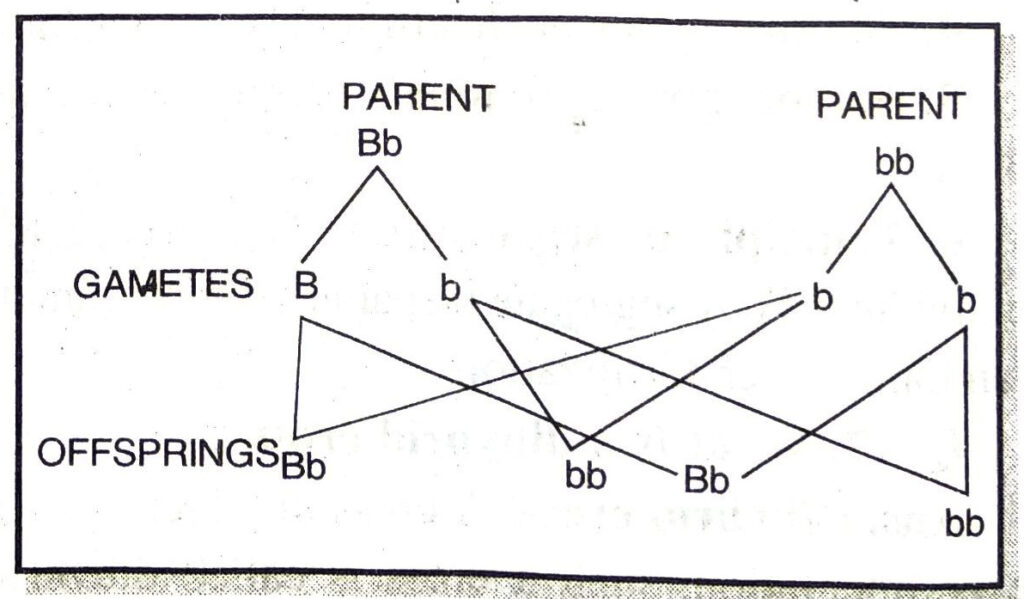
Ans. (a) Genotype of man: Bb
(Heterozygous)
Genotype of mother: bb
(homozygous recessive)
(b) Possible genotype of his father: Bb (Heterozygous) or BB (homozygous dominant)
(c) Cross between heterozygous man and homozygous recessive blue eyed woman Bb x bb
50% Blue eyed
50% Brown eyed
The ratio obtained is 1 : 1. It is an example of test cross also.
Q. 23. What is gene? What is nature of gene?
Ans. Gene. Term gene was coined by Johansen (1900). A hereditary determiner specifying a biological function; a unit of inheritance (DNA) located in a fixed place on the chromosome is called gene.
Mendel considered every character as unit which is controlled by a factor presently called gene. Chemically gene is a segment of DNA which controls one character and physically is a part of chromosome.
Q. 24. Where are genes located? What is the chemical nature of gene ?
Ans. Genes are located on chromosomes. Chemically gene is a segment of DNA (Deoxyribose nucleic acid).
Q. 25. In man four types of blood groups A, B, AB and O are controlled by three alleles of a gene. What is the mechanism of inheritance of the blood groups ?
Ans. More than two forms exists for certain genes. It is an example of multiple alleles. A well known example is ABO blood types in human. The four human blood groups, A, B, AB and O are phenotypes of the trait.
Three different alleles IA, IB and i of gene determine the phenotypes of the four blood groups. The six types of genotypes are as follows:

Both IA and IB are dominant over i. Since a person with genotype IAB has AB blood groups. It is an example of codominance.
Thus ABO blood groups exhibit three genetic aspects :
1. Dominant-recessive mechanism.
2. Multiple alleles
3. Co-dominance.
Q. 26. A man with type A blood has a wife with type B. They have a child with type O blood. Give the genotype of all the three. What other blood groups can be expected in the future offspring of this couple?
Ans. (a) Genotypes. Man (IA IO), Mother IB IO and child IO IO.
(b) Blood group of the future offspring. A type, B type, O type and AB type. It is based on the following cross:

Q. 27. What is Sex-determination ? Write down the role of environmental factors on sexdetermination. Give examples.
Ans. Sex-determination. Establishment of male and female individuals or male and female organs of an individual is called sex-determination. In human, males have autosomes +XY Sex-Chromosomes and Females have autosomes +XX sex chromosomes.
Effect of environment. In some animals environmental factors play role in sexdetermination.
1. The larva of sea worm Bonellia (an annelid) is sexually undifferentiated. Any larva coming in contact with already grown female, develops into small male.
2. Egg size. In another sea worm, Dinophulus, the size of eggs affect. Large sized egg develop into female and small sized egg develops into male.
VERY SHORT ANSWER TYPE QUESTIONS
Q. 1. What is heredity ?
Ans. Heredity is transmission of characters from one generation to next generation.
Q. 2. Name the following:
(i) Science that deals with the study of inheritance.
(i) Father of Genetics.
Ans. (i) Genetics
(ii) G.J. Mendel
Q. 3. Name the functional unit of hereditary material.
Ans. Gene.
Q. 4. Name the alternative forms of same gene.
Ans. Alleles.
Q. 5. Name the carriers of genes.
Ans. Chromosomes.
Q. 6. Define variations ?
Ans. Variations. Occurrences of smaller differences among the individuals of the same species.
Q. 7. Which process bring marked variations in the offspring.
Ans. Sexual reproduction.
Q. 8. Name the type of cell division in which chromosomes number is reduced to half.
Ans. Reductional division (meiosis).
Q. 9. How many chromosomes are found in human cells?
Ans. 46 (44 Autosomes and a pair of sex chromosomes).
Q. 10. How many chromosomes are present in the gametes of human beings ?
Ans. 23 chromosomes (22 autosomes + one sex chromosome (Y or X).
Q. 11. What is the modern term given to the factor of Mendel ?
Ans. Gene is the factor of Mendel. It is chemically a segment of DNA.
Q. 12. Name the plant on which Gregor J Mendel performed his experiments.
Ans. Pisum sativum (Garden pea plant).
Q. 13. How do homozygous and heterozygous organisms differ in terms of gametes produced by them ?
Ans. Homozygous have same factors or alleles controlling a character (TT or tt) and heterozygous have dissimilar alleles (factors) (Tt).
Q. 14. Why do recessive alleles fail to express their effects in presence of dominant allele?
Ans. This happens because the dominant alleles are complete polypeptide chains but the polypeptide chains or enzymes produced by recessive alleles are incomplete and defective.
Q. 15. What is locus ?
Ans. Site of gene (allele) on a chromosome is called locus.
Q. 16. Define a gene (give any one definition.)
Ans. Gene is a physical unit of heredity.
Q. 17. What other names were available for gene at the time of Mendel’s era ?
Ans. Alleles, traits, factors, units and particles.
Q. 18. Give any one character of gene.
Ans. Gene has a fixed position on a chromosome.
Q. 19. Expand DNA.
Ans. DNA. Deoxyribose nucleic acid.
Q. 20. What does DNA carry ?
Ans. Segment of DNA carries the codes for synthesis of protein.
Q. 21. What is chemical nature of gene ?
Ans. DNA.
Q. 22. What is a sex chromosome ?
Ans. The chromosome which determine the sex of an organism.
Q. 23. What will be in sex of the offspring developing from 44+ XX zygote ?
Ans. Female.
Q. 24. Man produces two types of sperms. Is it true ?
Ans. Yes. Androsperm (44 + Y) and Gynosperm (44 + X).
Q. 25. What are inherited traits ?
Ans. Inherited traits. The distinguishable feature of a character is called trait. The traits which are passed from parents to offsprings are called inherited traits.
Q. 26. What is Mendel’s monohybrid ratio ?
Ans. 3 :1.
Q. 27. Write down Mendel’s dihybrid ratio for phenotypes.
Ans. 9 : 3 3 : 1
Q. 28. Write the genotype of man with blood group ‘A’.
Ans. IAIA, IA, IO.
Q. 29. Name the molecule having information for making proteins in the cell.
Ans. DNA.
Q. 30. What is gene according to molecule structure ?
Ans. A segment of DNA that provides information for one protein is called gene for the protein.
Q. 31. What are two major functions of DNA ?
Ans. Replication and expression of genetic information in the form of polypeptide (Protein).
Q. 32. What do you mean by trait of a character ?
Ans. According to Mendel each character in an organism has two different features which are called two traits of a character (Tallness and Dwarfness for height).
ADDITIONAL IMPORTANT QUESTIONS
LONG ANSWER TYPE QUESTIONS
Q. 1. State the hypothesis of Oparin and Haldane about the primeval Earth condition. What do you understand by Haldane’s hot dilute soup? State its significance.
Ans. Alexander I. Oparin (1894-1980), a Russian biochemist and J.B.S. Haldane (1892-1964), a British scientist have put forward the concept of abiogenesis. According to Oparin and Haldane primeval earth had reducing condition and atmosphere is free from oxygen. Oxygen remained bound in H₂O and metallic oxides on the surface of rocks and its particles. The early gas cloud was rich in Hydrogen, in form of methane (CH4) and ammonia (NH3) and water (H₂O). The organic molecules formed due to the atmospheric reaction accumulated slowly and gradually in the sea and constitute what is called “hot dilute soup”.
Significance of hot dilute soup. Thus conditions of reducing nature are unable to oxidize these organic compounds which form the basis of life.
Q. 2. Summarise Miller’s simulation experiment for organic synthesis. Comment on its efficacy.
Ans. Miller’s experiment. Miller (1953) made the first successful simulation experiment to assess the validity of the claim for origin of organic molecules.
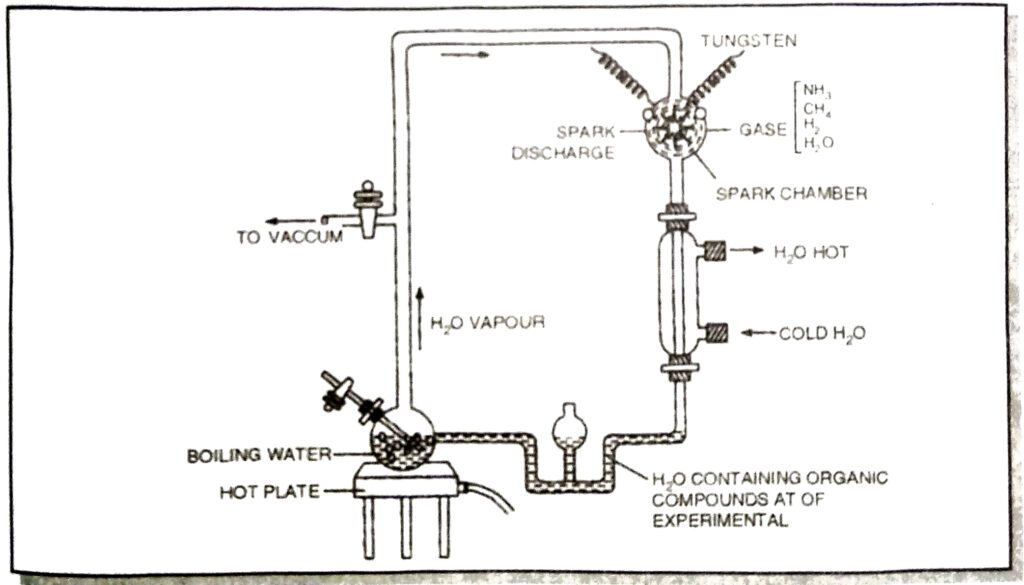
Miller sealed in a spark chamber a mixture of water, methane, ammonia, hydrogen gas. He made arrangement for boiling water. The trap in turn, was connected with the flask for boiling water. After 18 days, a significant amount of simple major organic compounds such as amino acids like glycine, alanine and aspartic acid and peptide chains began to appear. Simple sugars, urea and short chain fatty acids were also formed. In atmosphere, this spark is provided by U.V. light or other energy source.
Q. 3. Show by simple sketches how and what type of beetles survive due to variations in a population.
Ans. Variations in a population of beetles
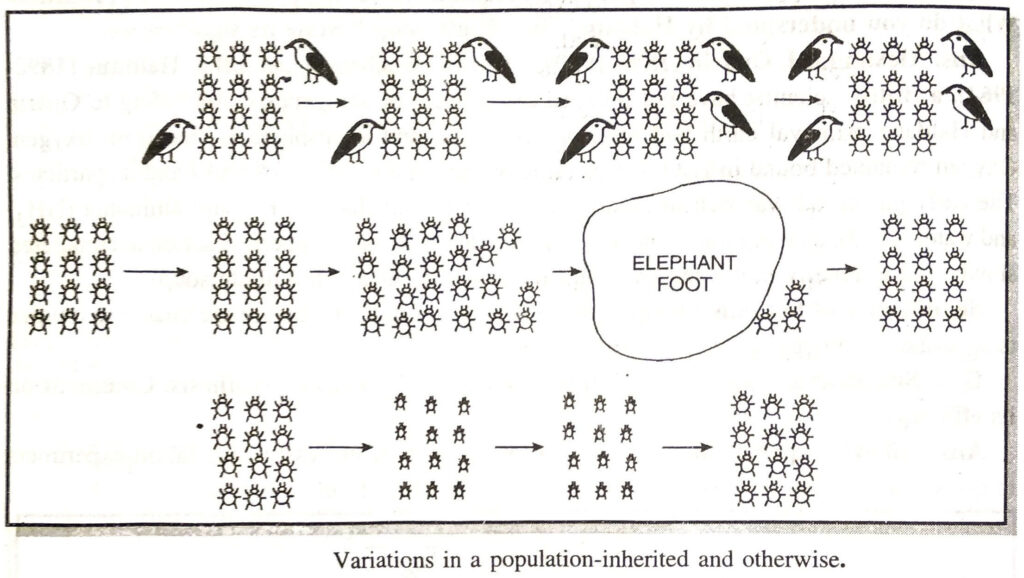
Q. 4. Explain with example how variation took place due to inheritance.
Ans. Variation in Population
The characteristics of a population change over the span of many years in different situation. Illustration 12 red beetles live in a green leafy bush grows by sexual reproduction and new individuals formed show variations.
Situation-I
Situation to gain advantage for serval
1. Crows eat these beetles, leaving only fewer beetles available for reproduction.
2. Due to colour variation during reciprocation, only one green beetle evolves and therefore, all its progeny beetles become green.
3. Crows cannot see green coloured beetles on green leaves and hence cannot eat them, resulting more green beetles than red ones in the beetle population.
4. This type of variation gives a survival advantage.
Situation-II
It is due to accidental survival
1. Due to colour variation during reproduction, a blue colour beetle appears and all its progeny beetles become blue.
2. Crows can see both red and blue beetles and therefore, eat them.
3. Initially there are less number of blue beetles and more of red beetles.
4. Then an elephant stumps on the bushes and kills most of the beetles. By chance, few beetles that survived were mostly blue.
5. Thus, the blue beetle population slowly expands.
6. There is no survival advantage on this variation and provides diversity without adaptation.
Situation-III
Temoranu change of characteristics.
1. As the beetle population begins to expand, the bushes suffer from a disease and amount of leaf available for beetles have reduced.
2. Thus, the beetles are poorly nourished and the average weight of an adult beetle has decreased.
3. After few years, the plant disease is eliminated and enough food is available for the beetles. Thus, the beetles have come back to its normal size and weight.
4. This change is not inherited over generation.
Thus variation enables the organisms to adapt themself in changing environmental condition. Variations form the family heredity. Variations are raw material of origin of new species.
Q.5. Define ‘Species’. What are the important factors leading to the rise of a new species?
Ans. Species. It is a group of organisms which resemble each other in structure and functions, interbreed among themselves to produce fertile young ones of their own kind. They has descended from a common as ancestor.
Steps involved in the evolution of new species :
Evolution of a new species of natural selection can be regarded as proceeding as follows:
1. Mutations and genetic recombination arise in a population.
2. Those which are not so harmful as to be lethal give rise to a balanced polymorphism.
3. Environmental change or migration of population favours certain varieties, which leave more offsprings which inherit these variations.
4. Isolation allows other favourable genes to accumulate in the population until it differs so much from the parental stock interbreeding become impossible.
Q. 6. Explain speciation.
Ans. Speciation. When environmental conditions change or a section of the population migrates to a new area with different environmental conditions, new species may arise. Origin of new species from the existing one is called speciation. In the changed environment, population may become adapted or die out. A population becomes adapted if its individuals have some new trait (genetic variation) which suits the changed environment and is selected by nature on this basis. The new trait spreads by differential reproduction, and in time becomes a standard feature of a section of the population. This is the unit of evolutionary change. Accumulation of many such unit changes in a section of the population may sufficiently alter the individuals in structure or function to become a new species. The latter are no longer able to interbreed with parental population.
Q. 7. Explain best adapted individuals contribute maximum to gene pool.
Ans. Best Adapted Individuals contribute maximum to Gene Pool. Which individuals produce more surviving offspring than others ? Generally those individuals which are best adapted to the environment, i.e., which have adaptive (beneficial) mutations, have greater number of surviving young ones. The well adapted individuals on the whole are healthier, and can find food and mate readily, and can better look after their offspring. Thus, the well adapted individuals contribute most to the gene pool.
Q. 8. Describe present day concept of evolution.
Ans. (1) Modern Concept of Evolution. The modern concept of evolution is a modified form of Darwin’s theory of natural selection and is often called Neo-Darwinism. It comprises genetic variation, natural selection and isolation.
(i) Mutations. These have been recognised as the ultimate source of biological changes and hence the raw material of evolution. The mutation in chromosomes may be due to changes in structure, number or gene.
(ii) Gene Recombination takes place during crossing over in meiosis. New combinations of genes produce new phenotypes.
(iii) Hybridisation is the intermingling of the genes of the members of closely related species.
(iv) Genetic drift is the elimination of the genes of some original characteristics of a species by extreme reduction due to different regions.
In monoparental reproduction only chromosomal and gene mutation are sources of genetic variation.
(2) Natural Selection. If differential reproduction (i.e. some individuals produce abundant offspring, some only a few and some organisms none) continues for many generations, genes of the individuals which produce more offspring will become predominant of the gene pool of the population. Thus natural selection occurs through differential reproduction in successive generations.
Migration of individuals from one to other population is an accessory factor for speciation (origin of new species).
(3) Isolation. By selecting the most suitable genotypes, natural selection guides different populations into different adaptive channels. The reproductive isolation between the populations due to certain physical barriers or others leads to the formation of new species. The isolation plays a significant role in evolution.
Q. 9. How human evolution take place over the years?
Ans. Human evolution.
The study of human evolution indicates that all of buman heings belong to a single species Homo sapiens that evolved in Africa.
1. DNA sequences have been used for studying human evolution.
2. Due to the diversified human forms and features, skin colour is the common way for identifying the races.
3. Few thousand years ago some ancestors left Africa while others stayed back.
4. The residents spread across Africa and the migrant spread across the planet from Africa to West Asia, Central Asia, Eurasia, South Asia, East Asia, Indonesia, Philippines, Australia 25 D and America.
5. They went forwards and backwards with groups separating from each other, or sometime coming together.
6. Like all other species, they were also living their lives to the best of their ability.
SHORT ANSWER TYPE QUESTIONS
Q. 1. What do you understand by origin of life ? Explain.
Ans. Origin of Life
The oldest surviving terrestrial rocks, about 4.3 billion years old, contain no definite trace of life, at least not recognisable as yet. Some rocks, about 3.9 billion years old, contain carbonates. Geologists interpret that these carbonates have resulted from life processes. Therefore, life was present on Earth about 3.9 billion years ago. However, the oldest microfossils discovered so far that of photosynthetic cyanobacteria.
Q. 2. Write the contribution of Urey and Miller.
Ans. Urey and Miller conducted experiment which supported that life originated by chemosynthesis. The chemosynthetic theory (Oparin-Haldane) states that life originated from non-living matter is based on the presence of methane and ammonia in the atmosphere. It required a high temperature, high energy radiations and electric discharges.
Q. 3. How does taxonomy support the evolution ?
Ans. The organisms which have similar characteristics are placed in a specific group. The characters taken for a definite group must be present either in the embryonic stages or in the adult stage. Fish, frog, lizard, bird and man are grouped together as vertebrates because all of them possess vertebral column.
Similarly, animal kingdom is divided into phyla, classes, orders, families, genera and species on the basis of similar character. Moreover, classifications are based on phylogeny.
Q. 4. What are homologous organs? Give examples.
Ans. Homologous organs. The organs of different classes have different forms because they have to perform different functions but their structures basically remains similar. Such organs are called homologous organs.
Examples of homologous organs. 1. The wings of bird and bat, flipper (fin) of whale, structure of human forearm are different in forms because these have to perform different functions. Studies of the bones forming the skeleton of these organs, would reveal similarity in construction. In fact, these are the forms of fore-arms which have originated from pentadactyl forms and due to the different functions they are performing hence transformed into different forms.
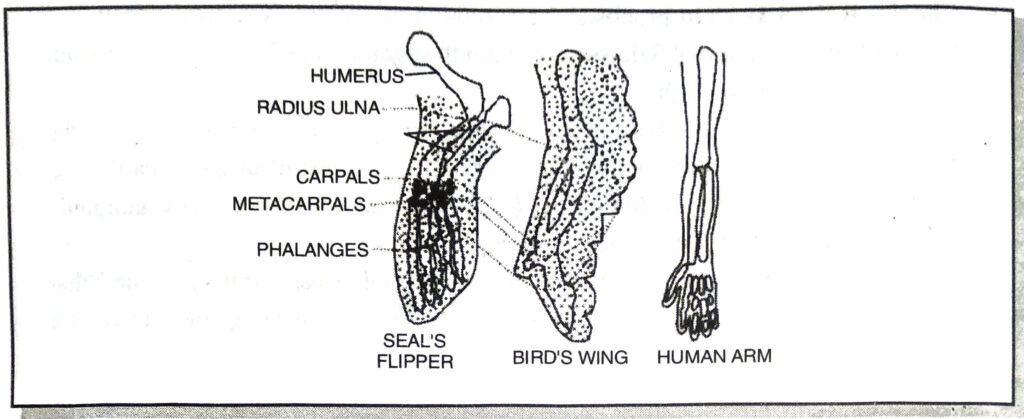
2. In plants, the homologous organs may be a thorn of Bougainvillea or a tendril of cucurbita both arising in axillary position.
Q. 5. What are analogous organs? Give examples.
Ans. Analogous organs. The organs which are similar in appearance and perform the same function but differ in their fundamental structure and origin are called analogous organs.
Examples. 1. Wings of birds and insects.
2. Leaves of a plant and cladodes of Ruscus are also analogous organs.
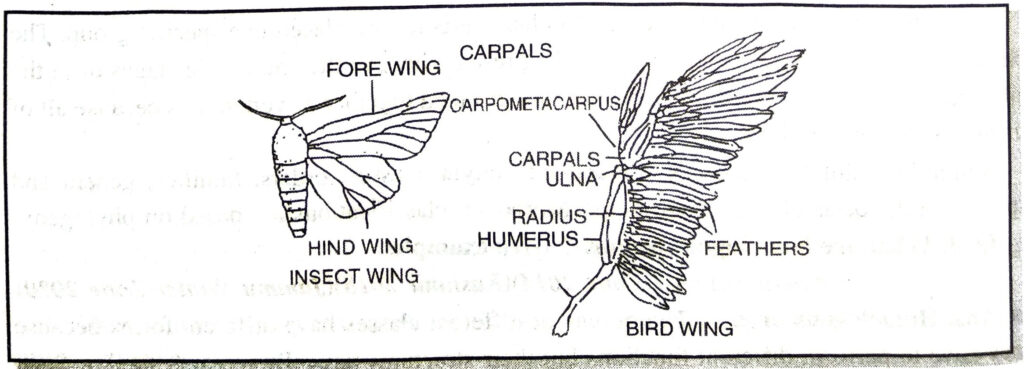
Q. 6. Differentiate homologous organs and analogous organs.
Ans. Differences between homologous organs and analogous organs
| Homologous Organs | Analogous Organs |
| 1. Some organs of different organisms resemble in structure and bear the same mit relation to the body. | 1. Th These organs which are functionally similar but morphologically different are called analogous organs. |
| 2. They have same fundamental plan of structure e.g. leaves of all higher plants arise from the nodes and bear an axillary bud in their axils. | 2. Their basic structure is different e.g. wings of vertebrates and insects perform the same function of flying. |
Q. 7. Define molecular homology
Ans. Molecular homology. Similarities of organisms at molecular level. Examples. 1. Resemblances of blood group 2. Blood proteins.
Q. 8. Are the fossils being formed at present time?
Ans. Fossil formation. Fossilization of a dead organism or its parts usually begins when it is buried before it has a chance to decay. The organism sinks into a bog or a marsh or to the bottom of a lake, sea or river. In some cases it is buried by wind driven sands. Even after burial decay can occur so that soft body parts decompose, a fact which emphasizes again that the hard parts are the ones that most commonly persist as fossil. The buried parts that do not decay are preserved and as mud or sand hardens to rock, the fossil becomes entombed.
Fossilization is a hit or miss effect. Only those organisms become fossilized that happen to die in a spot where they can be buried by natural process before their carcasses are destroyed by scavengers. Thus under such conditions fossils are being formed at the present time.
Q. 9. What is the physical method of determining of age of fossils ?
Ans. Determination of age of fossils (dating of fossils)
Once the fossils are unearthed palaeontologists try to determine their position in the historical sequence of life. The absolute age of fossil is difficult to calculate and older the fossil, less precise is the calculation.
Physical method. Before we begin to determine the age of fossil, we have to gain some perspective about the age of earth.
The age of the earth is estimated to be near about 300 crore years. This life span of earth has been divided into six principal eras. Out of these, three eras are subdivided into smaller span known as periods or epochs.
Q. 10. How does natural selection operate according to Darwin’s theory of natural selection ?
Ans. Natural selection operates in the following ways according to Darwin’s theory :
1. All plants and animals reproduce in geometrical pattern. The number of organisms produced are much more that can survive due to limited space and food.
2. Due to same basic requirement competition between organisms take place and those who are better adapted to environment survive while the rest die.
3. The individuals having useful variation overpower those without or having harmless variations and these variations are transmitted to future generations.
Q. 11. How evolutionary relationship can be traced ?
Ans. Evolutionary relationship can be traced in the following ways :
1. Study of homlogous organs.
2. Study of fossils.
3. Comparing DNA of different species.
Q. 12. Discuss the importance of artificial selection in the derivation of the concept of natural selection.
Ans. Importance of artificial selection. From his enquiries on breeding domesticating plants and animals, Darwin obtained clear evidence for selection, in this case of artificial selection. The breeders selected and perpetuated those variant types that interested them or seemed to be useful to them. Similar to artificial selection, natural selection also controls the speciation. But natural selection is too slow to observe.
Q. 13. What is variation ? Name the basic processes that cause variations among organisms. Discuss the role of migration in evolution.
Ans. Variations. The features which differ among the individuals are called variations.
Causes of variation. Mutation, recombination, gene migration, genetic drift and natural selection.
Role of Migration. Few populations are isolated from the other populations of same species, usually some migration takes place if the migrating individuals breed within the new population then immigrant will add new alleles to the local gene pool of host population.
Q. 14. Define variations in relation to species. Why is variation beneficial to the species?
Ans. (i) Variation. No living organisms are alike and they vary appreciably in many structural and functional aspects. These differences between individual organisms are called variations.
(ii) The useful variation in individuals of a species will enable them to adapt according to the changes and new needs. Thus they will enable the survival of the species.
Q. 15. Explain Genetic Drift.
Ans. Genetic Drift. The term genetic drift refers to the chance elimination of the genes of certain in traits when a section of population migrates or dies grates or dies of natural calamity. It dramatically alters the gene frequency of the remaining population. It eliminates certain alleles and fixes the other alleles, thereby reducing the genetic variability of the population. For example, in case of snowstorm, the individuals having alleles (characters) that provide resistance to cold survive, whereas others die.
Q. 16. What is Reproductive isolation ?
Ans. Reproductive isolation. Speciation is not likely to occur simply by changes in the Ans. Rented genotype of a population. The populations with different genotypes appearing in them must be isolated so that differences may accumulate to the level of speciation. Else interbreeding of emerging populations will result in mixing of their genotypes and disappearance of differences between them. Isolation preserves the integrity of a species by checking hybridisation.
Q. 17. Give a brief account of present day concept of evolution.
Ans. Present day concept of evolution
1. Appearance of genetic variations in certain individuals of a population by (i) migration, (ii) non-random mating, (iii) genetic drift, (iv) chromosomal changes, (v) gene mutation, (vi) recombination of genes, and (vii) hybridization.
2. Spreading of genetic variations in a sub-group of a population by natural selection through differential reproduction in successive generations.
3. Some sort of reproductive isolation of a subgroup of population having the genotypes selected by nature from other subgroups, and
4. Accumulation of genetic variations to sufficiently alter the individuals of the subgroup to become a new species.
Q. 18. How is the equal genetic contribution of male and female parent ensured in the progeny ?
Ans. In sexual reproduction, both the parents contribute equal amount of genetic material (genes) to the offspring. This means that for each trait there will be two alternatives in the sexually reproducing organisms. Out of these two alternatives, one is called dominant trait and the other is called recessive trait. There will besome progeny with new combination. DNA controls the traits and are copied from one generation to the next generation. Inaccuracies do occur during DNA copying which is more prominent in sexual reproduction. These variation in DNA copying gets inherited. Accumulation of variation generation after generation altogether leads to evolution of a new species.
Q. 19. How does the creation of variations in a species ensure survival ?
Ans. Genetic variations arise in sexually producing organisms as a result of following mechanism :
(i) Crossing over during gamete formation.
(ii) Random segregation of chromosome during meiosis at the time of gamete formation.
(iii) Random rejoining of gametes having different genetic set up in the chromosomes during fertilisation.
(iv) These variations from the raw materials of evolution.
Only variations that confer an advantage to an individual organism will survive in a population.
The organism with useful variations will adapt and survive. Moreover they leave behind more offsprings and populations with such genetic variations will survive.
SHORT ANSWER TYPE QUESTIONS
Q. 1. Define evolution in least possible words.
Ans. Descent with modification.
Q. 2. Would you regard evolution as a fact, a theory, a hypothesis, a doctrine, a principle or a concept?
Ans. It is a theory because it is based on causes and evidences.
Q. 3. What are the causes of inbuilt tendency of variations ?
Ans. 1. Sexual reproduction
2. Errors in DNA copying.
Q. 4. Why crows could not eat coloured beetles ?
Ans. Crows could not see green coloured beetles as they matched with green leaves and bushes.
Q. 5. What are vestigial organs ?
Ans. These are organs of body which are non-functional in the possessor but were functional in the ancestors and related organism.
Q. 6. What is meant by the term extinction ?
Ans. Elimination of a species is termed extinction.
Q. 7. Where will you find the most ancient and recent fossil ?
Ans. The most ancient fossils will occur in the older rocks, whereas most recent fossils will occur in the youngest rocks.
Q. 8. What is microevolution ?
Ans. A change in relative abundance of a gene (controlling a trait) within a population over a succession of generations is termed microevolution.
Q. 9. Define macroevolution.
Ans. Macroevolution involves large scale changes among group of species.
Q. 10. Genetic drift occur in small or large population.
Ans. Small in number.
Q. 11. The species sharing more common characteristics will be close or distant related ?
Ans. Closely related.
Q. 12. Give the three key factors of the modern concept of evolution.
Ans. Genetic variations, natural selection and isolation.
Q. 13. Name any fossil animal which serves as connecting link. Which two groups does it connect? 2
Ans. (i) Archaeopteryx (ii) It is a connecting link between reptiles and birds.
Q. 14. What was the common character on which races of human populations were determined.
Ans. Skin colour.
MULTIPLE CHOICE QUESTIONS
Select the correct answer out of the four alternatives :
1. The unit of heredity is :
(A) chromosomal
(B) DNA
(C) SNNA
(D) gene.
Ans. (D) gene.
2. Mendel worked on :
(A) Edible pea
(B) Wild pea
(C) Garden pea
(D) None of these.
Ans. (C) Garden pea
3. In a monohybrid cross, we get a genotypic ratio of :
(A) 1 : 2 : 1
(B) 1 : 1 : 2
(C) 3 : 1
(D) 2 : 2 : 2.
Ans. (C) 3 : 1
4. Mendel’s law of independent assortment is based on F₂ ratio of:
(A) 1 : 2 : 1
(B) 9 : 3 3 : 1
(C) 2 : 1
(D) 3 : 1.
Ans. (B) 9 : 3 3 : 1
5. The genotype of B-Group father of an O-group child would be:
(A) IB IO
(B) IB IB
(C) IA IB
(D) IOIO
Ans. (A) IB IO
6. In evolutionary terms, we have more common with :
(A) Chinese school boy
(B) a chimpanzee
(C) a spider
(D) a bacterium.
Ans. (B) a chimpanzee
7. The sex of child depends upon chromosome bsdr present in :
(A) Egg of female
(B) Sperm of male
(C) Both (A) and (B)
(D) None of these.
Ans. (C) Both (A) and (B)
8. The process of evolution :
(A) is a continuous process
(B) is a discontinuous process
(C) was continuous in the beginning but discontinuous now
(D) was discontinuous in the beginning but continuous now.
Ans. (A) is a continuous process
9. The wings of bat and birds are :
(A) Homologous but not analogous
(B) Neither homologous nor analogous
(C) Analogous but not homologous
(D) Vestigial.
Ans. (A) Homologous but not analogous
10. Which one of the following sets of structures includes only analogous organs ?
(A) Hind legs of horse, grass hopper and bat
(B) Hands of man, monkey and kangaroo
(C) Mandibles of cockroach, mosquito and honeybee
(D) Wings of butterfly, housefly and bat.
Ans. (D) Wings of butterfly, housefly and bat.
11. The differences between two individual is due to the difference in :
(A) DNA and Protein
(B) DNA and RNA
(C) DNA only
(D) RNA only.
Ans. (C) DNA only
12. An example of homologous organs is :
(A) Our arm and dogs fore leg
(B) Our teeth and an elephant’s tusk
(C) Potato and runners of grass
(D) All of above.
Ans. (A) Our arm and dogs fore leg
13. Which of the following in the cell nucleus is the information source for making protein ?
(A) RNA
(B) DNA
(C) Vacuole
(D) Lysosome.
Ans. (B) DNA
14. The amount of DNA in a new generation is :
(A) double than parent
(B) equal to the previous
(C) half of the previous
(D) three time than the previous generation.
Ans. (B) equal to the previous
15. In evolutionary terms, we have more in common with :
(A) Chinese school boy
(B) A Chimpanzee
(C) A Spider
(D) A Bacterium.
Ans. (B) A Chimpanzee
16. The tools for tracing evolutionary relationship include:
(A) excavating
(B) time dating and studying fossils
(C) determining DNA sequence
(D) all of above.
Ans. (D) all of above.
17. A Mendelian experiment consisted of breeding tall pea plants bearing violet flowers with short pea plants bearing white flowers. The progeny bore all violet flowers, almost half of them were short, this suggests that the genetic make-up of the tall parent can be depicted as:
(A) TTWW
(B) TTww
(C) Ttww
(D) TtWw.
Ans. (C) Ttww
18. The gene contains chemically :
(A) DNA
(B) RNA
(C) Chromosome
(D) Both DNA and RNA.
Ans. (A) DNA
19. The male human sex chromosome is represented by :
(A) XX
(B) yy
(C) XY
(D) None of above.
Ans. (C) XY
20. Sex of the child depends upon the sex chromosome present in :
(A) Egg of female
(B) Sperm of male
(C) Both male and female
(D) None of above.
Ans. (C) Both male and female
21. Darwin’s theory does not include:
(A) Natural selection
(B) Survival of the fittest
(C) Evolution through inheritance
(D) Struggle for existence.
Ans. (C) Evolution through inheritance
22. In monohybrid cross the F₁ generation contains ) :
(A) Pair of genes of contrasting characters
(B) Single gene of only one character
(C) Pair of genes of same characters
(D) Single gene for all characters.
Ans. (A) Pair of genes of contrasting characters
Follow on Facebook page – Click Here
Google News join in – Click Here
Read More Asia News – Click Here
Read More Sports News – Click Here
Read More Crypto News – Click Here